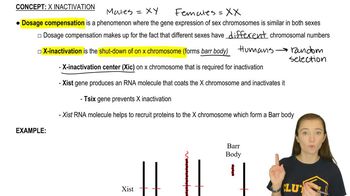Here are the essential concepts you must grasp in order to answer the question correctly.
Nucleic Acids
Nucleic acids, including DNA and RNA, are biopolymers essential for all known forms of life. They are composed of nucleotide monomers, which contain a sugar, a phosphate group, and a nitrogenous base. DNA typically serves as the genetic blueprint, while RNA plays various roles in protein synthesis and gene regulation. Understanding the structure and function of nucleic acids is crucial for analyzing genetic material.
Recommended video:
X-ray Diffraction
X-ray diffraction is a technique used to study the atomic structure of crystalline materials, including biological macromolecules like DNA. When X-rays are directed at a crystal, they scatter in specific patterns that can be analyzed to reveal information about the arrangement of atoms. The diffraction pattern provides insights into the dimensions and regularity of the nucleic acid structure, which is vital for understanding its properties and functions.
Recommended video:
Eukaryotic Cells
Eukaryotic cells are complex cells characterized by the presence of a nucleus and membrane-bound organelles. They can be unicellular or multicellular and include organisms such as plants, animals, and fungi. The discovery of a primitive eukaryote with unique genetic material suggests evolutionary significance and may provide insights into the diversity of life forms and their genetic mechanisms.
Recommended video:
 Verified step by step guidance
Verified step by step guidance Verified video answer for a similar problem:
Verified video answer for a similar problem:


 9:32m
9:32m